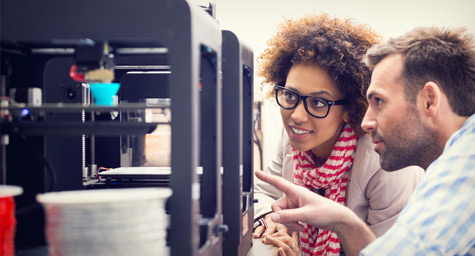4 Ways 3D Printing Will Transform Commerce
Recently the media has been talking a lot about 3D printing, the mesmerizing process of creating physical objects from digital plans. However, many of these reports have focused on whimsical or dangerous uses of the technology, such as the ability for individuals to create guns and toys.
What has been talked about less is the fact that many professions—including doctors, dentists, and landscapers—are already incorporating 3D printing into their operations.
Moreover, this expansion into the business realm is set to accelerate as costs come down and both the hardware and software become more sophisticated. That means our entire concept of commerce—of creating and selling things—could soon change drastically.
Why? Here are four key reasons:
1. Small-Scale Manufacturing Will Become More Cost-Effective
People often wrap their heads around 3D printing by thinking about the desktop inkjet/laser printers they have in their homes. This isn’t necessarily wrong—many households could indeed have individual 3D printers one day—but when it comes to the technology’s impact on commerce, a better model may be your local copy shop.
Just as those services made it economical to print things—flyers, posters, cards, etc.—locally, 3D printing has the potential to change the logistics of manufacturing other goods.
Relatively inexpensive industrial 3D printers could make it possible to match regional demand with regional supply, rather than needing to produce everything at scale in a faraway factory and have it shipped.
As Richard D’Aveni wrote last year in the Harvard Business Review:
“[With 3D printing] more goods will be manufactured at or close to their point of purchase or consumption…Whereas cars today are made by just a few hundred factories around the world, they might one day be made in every metropolitan area.”
2. The Whole Concept of Inventory Will Change
Why does the rise of small-scale manufacturing matter so much? Because it will transform the entire concept of inventory.
Since the Industrial Revolution, we’ve basically had the same model for selling physical things: they are made somewhere, delivered to somewhere else, stored, then sold. Even Amazon, as transformative as it has been to commerce, mainly functions this way.
3D printing, in an odd way, may bring us back to the days of blacksmiths and haberdashers, when creation happened in the moment, with very little inventory kept on hand.
An example of this phenomenon already in action is this orthotic insole manufacturer, which uses 3D printers to keep costs down by creating product only when ordered. As Kegan Schouwenburg, the company’s CEO told Forbes: “One of the great things about digital on-demand technologies (3D printing) is that by minimizing overhead and wasteful costs like inventory, they make it possible to align cost and value in a way never before possible.”
3. True Customization Will Be Scalable
Another huge change that 3D printers may bring about is the further personalization of physical goods; businesses will be able to move away from Henry Ford’s Model T system where each version of a product must be essentially the same to keep manufacturing costs low.
With local, on-demand manufacturing a reality, it should be truly possible to personalize almost anything without the price being prohibitive.
Again, this has become somewhat of a reality; a jewelry designer is already creating these one-of-a kind pieces using a prototype 3D printer. Imagine that same level of individualization, at scale, for almost any product, from a lamp to a truck.
4. Intellectual Property Will Be the Battleground
Finally, all this will likely make intellectual property even more important.
In some ways, this change is simply an extension of what’s been happening over the past few decades with the rise of digital products and services. The major technology companies all fiercely guard their patents and software because it is those original concepts and code that truly differentiate them.
Similarly, as manufacturing and distribution become increasingly localized and commoditized, 3D printing could lead to companies of all sorts to compete on ideas. Eventually it may matter less who has the best relationship with a factory in China, and more who controls the instructional elements of an original design.
That, of course, is a whole new way of thinking—but it could result in amazing, lucrative new products. That, ultimately, would be a win for consumers and companies alike.
Gain insight into 3D printing and other high-tech trends. Contact MDG today at 561-338-7797 or visit www.mdgsolutions.com.
MDG is a full-service advertising agency and one of Florida’s top branding firms. With offices in Boca Raton and New York City, MDG’s core capabilities include branding, logo design, print advertising, digital marketing, mobile advertising, email marketing, media planning and buying, TV and radio, outdoor advertising, newspaper, video marketing, Web design and development, content marketing, social media marketing, and SEO. To discover the latest trends in advertising and branding, contact MDG today at 561-338-7797.

